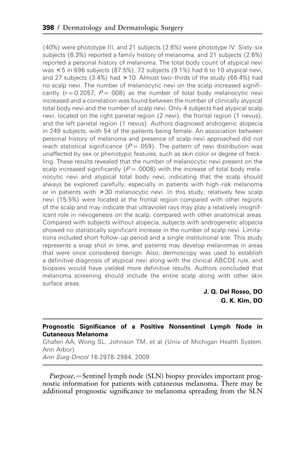Prognostic Significance of a Positive Nonsentinel Lymph Node in Cutaneous Melanoma
January 2011
in “
Yearbook of Dermatology and Dermatologic Surgery
”

TLDR Finding a positive nonsentinel lymph node in melanoma patients indicates a worse prognosis.
The study examined the prognostic significance of a positive nonsentinel lymph node (NSLN) in patients with cutaneous melanoma who already had a positive sentinel lymph node (SLN). Out of 429 patients with positive SLN biopsies, 71 (17%) had at least one positive NSLN. The median follow-up time was 36.8 months. The presence of a positive NSLN was significantly associated with a poor outcome, although long-term survival was still possible. Multivariate analysis identified several predictors of overall survival, including increasing age, Breslow depth, presence of extracapsular extension in the SLN, and positive NSLN. The study concluded that a positive NSLN is a highly significant poor prognostic sign, suggesting that complete lymph node dissection after a positive SLN biopsy provides important prognostic information. However, the study also acknowledged that further research, including serial sectioning and/or immunostaining, is needed to confirm NSLN status as an independent prognostic factor.